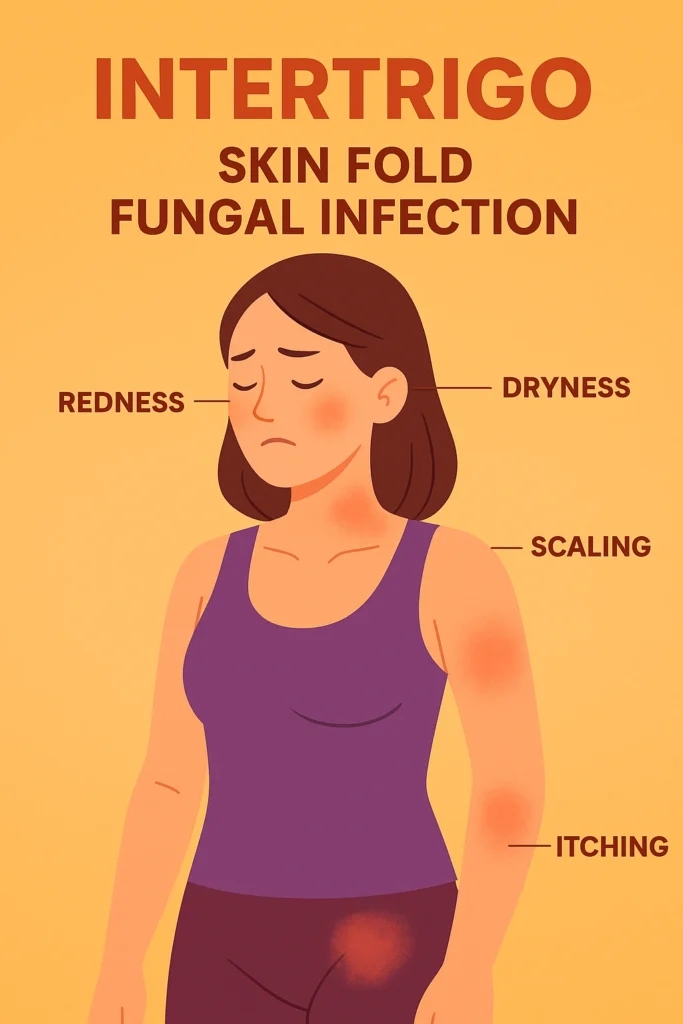Learn how to recognize, treat, and prevent intertrigo — the skin fold fungal infection common in warm, moist areas. Practical guidance for women’s skin health and long-term care.
Understanding Intertrigo: What It Is
Intertrigo is a common inflammatory skin condition that occurs in areas where skin folds rub together, creating warmth, friction, and moisture — an ideal environment for fungal or bacterial growth. In women, it often appears under the breasts, between the thighs, beneath the abdomen, or in the armpits. This condition can cause redness, itching, and a burning sensation that becomes worse with heat and humidity.
While intertrigo can affect anyone, women are particularly vulnerable due to anatomical and hormonal factors that increase skin moisture and friction in certain body areas. The infection is not contagious but can cause significant discomfort if left untreated.
Common Causes of Intertrigo
The primary cause of intertrigo is **skin-on-skin friction** combined with **moisture buildup**. Sweat, heat, and lack of air circulation in skin folds create a perfect environment for inflammation and secondary infections. Common causes include:
- Excessive sweating: Especially during exercise or in hot climates.
- Tight clothing: Restrictive garments trap sweat and irritate the skin.
- Obesity: Larger skin folds retain moisture more easily.
- Poor hygiene: Infrequent washing or drying of body folds can worsen irritation.
- Fungal infections (Candida): The yeast Candida albicans often infects irritated skin folds.
- Prolonged moisture exposure: From swimming, wet clothing, or sweating.
Signs and Symptoms
The symptoms of intertrigo can range from mild irritation to severe infection. Women often report:
- Red, inflamed patches of skin in the folds.
- Burning or itching sensation.
- Cracked or oozing skin.
- Foul odor caused by bacterial overgrowth.
- In severe cases, pain or secondary yeast infection with white, moist lesions.
If untreated, the affected skin can break down and become infected with bacteria or fungi, worsening the inflammation and discomfort.
Who Is at Risk?
Certain groups of women are more prone to intertrigo:
- Women with larger breasts or body folds.
- Those living in hot, humid environments.
- Postpartum women due to hormonal and sweat changes.
- Women with diabetes, obesity, or compromised immunity.
- Those wearing synthetic or tight-fitting clothing regularly.
Diagnosis and Medical Evaluation
Diagnosis is usually clinical, based on the typical location and appearance of the rash and risk factors. To guide appropriate therapy and rule out other conditions, clinicians may:
- Inspect the area and look for satellite lesions suggestive of Candida.
- Perform a skin scraping or swab for microscopy and culture to identify Candida, dermatophytes, or bacteria. Potassium hydroxide (KOH) prep is a rapid test to detect fungal elements.
- Consider bacterial culture when purulent drainage or strong odor suggests bacterial overgrowth.
- Evaluate for underlying conditions such as diabetes if intertrigo recurs or is severe.
- Rule out other differential diagnoses such as inverse psoriasis, contact dermatitis, hidradenitis suppurativa, or erythrasma (a Corynebacterium infection that fluoresces coral-red under Wood’s lamp).
Effective Treatment Options
Treatment for intertrigo focuses on reducing inflammation, eliminating infection, and keeping the affected area dry. Depending on severity, a combination of the following treatments may be used:
- Antifungal creams: Such as clotrimazole or miconazole to treat yeast infections.
- Barrier creams or powders: Zinc oxide or talcum-based products help reduce friction.
- Topical corticosteroids: Used to calm inflammation and redness (short-term use only).
- Antibiotic creams: If bacterial infection is present.
- Proper hygiene: Gently washing and drying affected areas daily.
- Loose, breathable clothing: Wearing cotton fabrics reduces sweating and irritation.
Home Remedies and Self-Care Tips
Many women find relief from intertrigo through home management strategies that focus on keeping the skin cool and dry. Here are some simple but effective steps:
- Clean affected areas with mild soap and warm water, then pat dry gently.
- Apply a thin layer of antifungal powder or cornstarch to absorb moisture.
- Use soft cloths or absorbent pads between skin folds to reduce friction.
- Take breaks from tight undergarments and choose breathable fabrics.
- Maintain a healthy weight and stay hydrated to prevent excess sweating.
General supportive measures
- Keep the area clean and dry: Gently cleanse with water and a mild, pH-balanced cleanser; pat dry thoroughly.
- Improve ventilation: Wear loose, breathable cotton clothing and avoid synthetic fabrics.
- Use barrier products: Zinc oxide, petroleum jelly, or barrier creams can protect raw skin from moisture.
- Weight management and mobility: When possible, weight loss and frequent position changes reduce fold persistence and pressure.
- Address incontinence promptly and use absorbent, breathable pads if needed.
Topical antifungal therapy (for candida)
- First-line: topical azole antifungals such as clotrimazole or miconazole applied twice daily for 2–4 weeks.
- Severe or extensive candidal intertrigo: oral fluconazole may be prescribed for systemic control.
- For recurrent cases, longer courses or combination topical therapy may be needed under medical supervision.
Topical antibacterial therapy (for bacterial superinfection)
If bacterial infection is suspected, topical antibiotics (e.g., mupirocin) or systemic antibiotics may be required based on culture results.
Erythrasma caused by Corynebacterium typically responds to topical erythromycin or systemic erythromycin.
Topical corticosteroids
Short courses of low-to-moderate potency topical corticosteroids can reduce inflammation and pruritus, but should be used cautiously and for limited duration because they can worsen fungal growth if used alone. Often corticosteroids are combined with antifungal creams when inflammation is prominent.
Adjunctive and advanced treatments
- Anti-fungal powders or drying powders (e.g., miconazole powder or tolnaftate) help reduce moisture in the folds.
- Absorbent dressings and moisture-wicking pads can be used for large or persistent folds.
- For chronic or resistant cases, dermatology referral for systemic therapy or further evaluation may be necessary.
Prevention Tips for Women
Preventing intertrigo centers on reducing moisture and friction and addressing systemic risk factors. Practical steps include:
- Choose breathable fabrics: cotton and moisture-wicking activewear reduce humidity.
- Use absorbent under-bra liners or skin fold tapes for under-breast areas.
- Maintain healthy weight and practice gradual weight reduction if advised by a clinician.
- Control blood sugar for those with diabetes to reduce Candida risk.
- Shower after heavy sweating and change into dry clothes promptly.
- Apply a thin barrier cream or absorbent powder to vulnerable folds, especially in hot months.
- Address incontinence with appropriate products and timely cleansing.
- Promote air circulation: elevate the affected area when resting and avoid prolonged sitting.
Consistent skin care routines can significantly reduce flare-ups and help you stay comfortable even during hot or humid weather.
When to See a Doctor
Seek medical care if:
- The rash is painful, spreading rapidly, or does not improve with basic measures in 5–7 days.
- You see pus, thick discharge, fever, or swollen lymph nodes.
- Intertrigo recurs frequently despite prevention steps.
- You have diabetes or other immune-suppressing conditions and develop any skin infection signs.
- You are unsure of the diagnosis — some conditions (inverse psoriasis, hidradenitis) require different treatments.
FAQs
Q: Is intertrigo contagious?
A: The inflammatory condition itself is not contagious, but secondary infections (Candida or dermatophytes) can be transmissible via direct contact or shared damp items like towels.
Q: How long does candidal intertrigo take to clear?
A: With appropriate topical antifungal therapy and drying measures, many cases improve within 1–2 weeks; severe or recurrent infections may require longer or systemic therapy.
Q: Can talcum powder prevent intertrigo?
A: Powder that absorbs moisture and does not clump may help, but traditional talc can clump when wet and irritate. Use medical-grade moisture-wicking powders or recommended antifungal powders.
Q: Are there special considerations for breastfeeding women?
A: Intertrigo under the breasts requires careful management to avoid nipple irritation. Use safe, cream-based barriers and consult a lactation consultant or physician before using medicated products near the nipple.
Final Thoughts



Pingback: Common Types of Fungal Infections in Women and Prevention